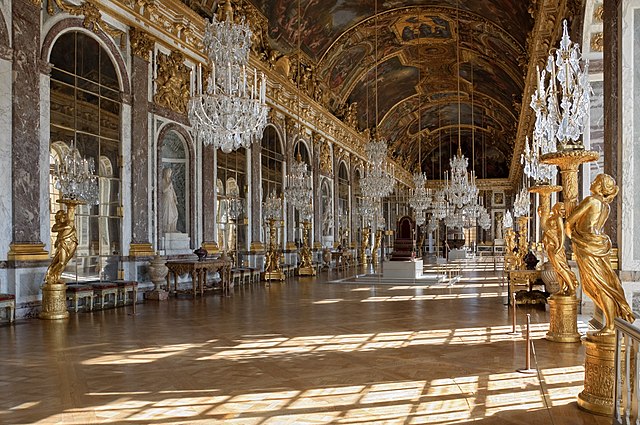The Château de Versailles, located near Paris, France, is one of the most renowned and opulent palaces in the world. Here’s an exploration of the opulence that defines this historic masterpiece:
1. Palace Architecture:
- The palace’s architecture is a prime example of French Baroque style, characterized by grandeur, symmetry, and intricate detailing. The use of gold leaf, marble, and sculpted ornamentation contributes to its opulent appearance.
2. Hall of Mirrors (Galerie des Glaces):
- The Hall of Mirrors is the most famous room in the palace, featuring 17 large mirrors opposite 17 windows, reflecting the gardens and flooding the hall with natural light. Gilded decorations and crystal chandeliers add to the lavishness.

3. Royal Apartments:
- The royal apartments, including those of King Louis XIV, are adorned with luxurious fabrics, rich tapestries, and gilded furniture. Each room is meticulously decorated to reflect the grandeur of the French monarchy.
4. Gardens and Park:
- The expansive gardens and park surrounding the palace are a testament to opulent landscaping. Designed by André Le Nôtre, they feature meticulously manicured lawns, fountains, sculptures, and geometric patterns.
5. Palace Chapel (Chapelle Royale):
- The Palace Chapel is a stunning example of French Gothic architecture. The chapel’s interior is adorned with religious art, including paintings and sculptures, showcasing the close connection between royalty and the Church.
6. Apollo Fountain:
- The Apollo Fountain in the gardens is a masterpiece of sculpture and hydraulics. The central statue depicts Apollo riding his chariot, symbolizing the Sun King, Louis XIV.
7. Royal Opera (Opéra Royal):
- The Royal Opera at Versailles is a marvel of 18th-century theater architecture. The lavish interior includes red velvet, gold leaf, and a royal box for the king.
8. Grand Trianon:
- The Grand Trianon, a smaller palace on the estate, was a retreat for the royal family. Its pink marble and porphyry columns, along with exquisite interior design, showcase another facet of opulence.
9. Marie Antoinette’s Estate:
- The Petit Trianon and Queen’s Hamlet within Marie Antoinette’s estate reflect her desire for a simpler, pastoral escape. The Petit Trianon itself, however, is still a manifestation of luxury and refinement.
The Château de Versailles stands as a symbol of absolute monarchy and opulence in the 17th and 18th centuries. Its architecture, gardens, and interiors collectively showcase the wealth, power, and artistic achievements of the French monarchy during this period.











